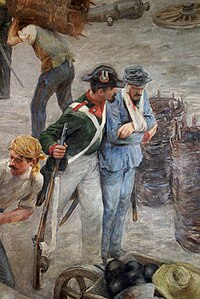Revolutions of 1848 in the Italian states
| Italian Revolutions of 1848 in the Italian states | |||||||||
|---|---|---|---|---|---|---|---|---|---|
| Part of the Wars of Italian Unification | |||||||||
 Italian soldiers in defense of Venice against the Austrians |
|||||||||
|
|||||||||
| Belligerents | |||||||||
|
Supported by: |
|
||||||||
| Commanders and leaders | |||||||||
|
|
|
||||||||
The 1848 revolutions in the Italian states were organized revolts in the states of the Italian peninsula and Sicily, led by intellectuals and agitators who desired a liberal government. As Italian nationalists they sought to eliminate reactionary Austrian control. During this time period, Italy was not a unified country, and was divided into many states, which, in Northern Italy, were ruled by the Austrian Empire. A desire to be free from foreign rule, and the conservative leadership of the Austrians, led the Italian people to stage revolution in order to drive out the Austrians. The revolution was led by the state of Piedmont, one of the four states where the Austrian leaders were forced to grant liberal rights. Also, the uprisings in the Kingdom of Lombardy–Venetia, particularly in Milan, forced the Austrian General Radetzky to retreat to the Quadrilatero (Quadrilateral) fortresses.
King Charles Albert, who ruled Piedmont-Sardinia from 1831 to 1849, aspired to unite Italy under his leadership. He declared war on Austria and launched a full-out attack on the Quadrilateral. Lacking allies, Charles Albert was no match for the Austrian army. He was defeated at the Battle of Custoza (July 24, 1848), signed a truce, and withdrew his forces from Lombardy. Austria remained dominant in a divided Italy and the Revolution was lost.
In 1848, what is now modern day Italy was composed of the following duchies, states, or kingdoms: in the southern Italian peninsula and the island of Sicily was the Kingdom of the Two Sicilies, in the central Italian peninsula was the Papal States, in the north were the three Duchies of Parma, Tuscany and Modena, in the northwest was the Kingdom of Sardinia, which consisted of Nice, Genoa, Savoy, mainland Piedmont, and the island of Sardinia. The economy was heavily based on agriculture. Farm products were subject to unstable prices due to foreign competition, and the slowness of Italian farming contrasted to more efficient foreigners. There were food riots all through 1840 to 1847; radical groups proliferated in Rome.
...
Wikipedia
